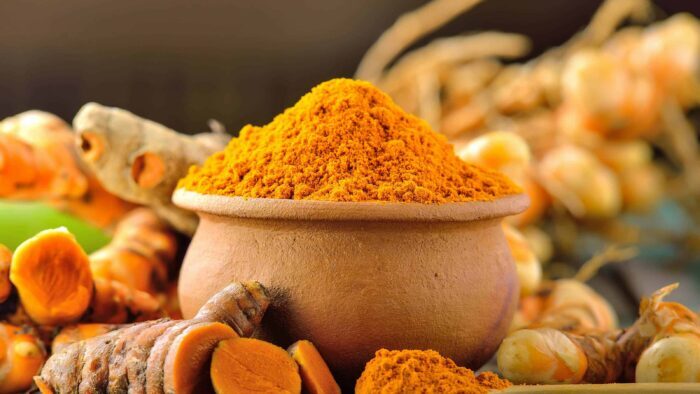Haldi is the most celebrated common spice, having a fragrant aroma and can be found in almost every Indian kitchen. Today, India produces nearly all of the world’s Turmeric crop owing to the suitable tropical-high rainfall climate. 80 percent of this cultivation is consumed domestically. Marco Polo on his way to India via the Silk Route was so impressed by it that he compared it with saffron, and so today it is also called ‘Indian Saffron’.
Looking back at Turmeric
The history and mystery of Indian cuisine stretches back to the ancient Indus Society, where spices such as Turmeric, Ginger, Pepper etc., have been discovered from many Harappan sites. Arunima Kashyap & Steve Weber’s study on Harappan Plants identified starch of curcuma in one of the Harappan handi (cooking pot), indicating what could have been the world’s oldest kari or curry, a spicy vegetable/meat sauce. Did you know that we have been consuming this yellow spice for the past 8000 years?
Be it ancient Indus meals or grand nosh-ups of international Michelin star restaurants, Indian curry remains a timeless favourite! Dropping below are some of Chef Anna Hansen’s fusion cooking blends using Turmeric.
Before it was commonly used as a spice for food, Turmeric was used as a medicine during the Vedic period. From India, it is believed to have travelled to China, Africa and America. This demand for Indian spices is believed to have facilitated the trade routes, very much a globalisation process.
As one of India’s Soft Power ambassadors, the sunshine of Turmeric provides for varied everyday uses. As a superfood in everyday cooking – the compound Curcumin which happens to be the main ingredient in Turmeric possesses powerful healing properties to the extent that its anti-inflammatory properties are believed to rival those of ibuprofen. Consuming it with food is helpful for gastrointestinal issues, feelings of depression and turmeric juice helps heal wounds, something which is promoted by both Ayurveda and traditional Chinese medicine.

Turmeric in traditional medicine
Unani practitioners vouch for Turmeric to be used in food to expel kapha (phlegm) and improve blood circulation. In around 500 BC, turmeric became an important part of Ayurveda, an ancient system of Indian medicine that mentions about 100 including jayanti. The overall Ayurvedic perspective on this vibrant spice provides for wonderous results - balances all the doshas, cleanses toxins from the body, and maintains health.
Turmeric is believed to neutralise the free radicals responsible for damage relating to aging. In Panchkarma applications, Haridra, another name of turmeric, translates as ‘beneficial for skin diseases. Several multinational companies also use Turmeric in the manufacturing of face creams and sunscreens.
Our mothers’ belief in the power of this culinary super spice was real after all! All that glitters of Turmeric is indeed gold.
Turmeric during the pandemic
Courtesy COVID-19, the Scientific Community around the world has once again turned towards India’s traditional scientific knowledge system in a search for alternative medicine to fight the virus.
Ashwagandha, Moringa, Tulsi, Guduchi and Turmeric – principal condiments known to India since ancient times and in use since about 5000 years as common home remedies – are today being welcomed by the West with zest into their own lifestyles, especially as preventive medicine – to boost immunity and overall energy of the body. The gems that make for an integral part of the traditional Indian medicine systems like Ayurveda, Unani and Siddha are being widely studied by the West. Memorial Sloan Kettering Cancer Center and University of Maryland Medical Center summarise the studies relating to the benefits of Turmeric undertaken by the West.
In Indian culture, turmeric goes far beyond medicine and is deemed to be auspicious and sacred. From being used in wedding day traditions to adorning gods with haldi tilaks and swastikas. The power of turmeric in Indian culinary traditions works as an adhesive to bring Indians.
Turmeric in Gujarati Cuisine
In Gujarati thalis, the yellow-coloured presence of Turmeric flavour and aroma is reflective of Gujarat’s golden cultural cuisine. A special mention has to be made for the bright, spicy and sour GUJARATI DAL (soupy lentil dish) that is seasoned with many spices, including the super spice of Turmeric. The highlight of a Gujarati thali would be the Gujarati Kachcha Haldi ka Achaar (Fresh Turmeric Pickle), an age-old Gujarati relish prepared by only using turmeric, lemon and salt. Listing out some of these lip-smacking snacks, a delight for vegetarians world over.
 The fame of all these traditional and nutritional Gujarati dishes is not only limited to the Gujarati diaspora but is widely enjoyed beyond the national borders also. From traditional Sciences to modern Sciences, from households to medical centers, the golden spice is undeniably having a ‘panacea moment’ everywhere!
The fame of all these traditional and nutritional Gujarati dishes is not only limited to the Gujarati diaspora but is widely enjoyed beyond the national borders also. From traditional Sciences to modern Sciences, from households to medical centers, the golden spice is undeniably having a ‘panacea moment’ everywhere!
REFERENCES
https://www.ncbi.nlm.nih.gov/books/NBK92752/
https://www.gujarattourism.com/gujarati-cuisines.html?cid=14
This article is authored by Ms Tanya Chaudhary, currently volunteering with CSP. Tanya is a political science student at Hindu College, University of Delhi.





